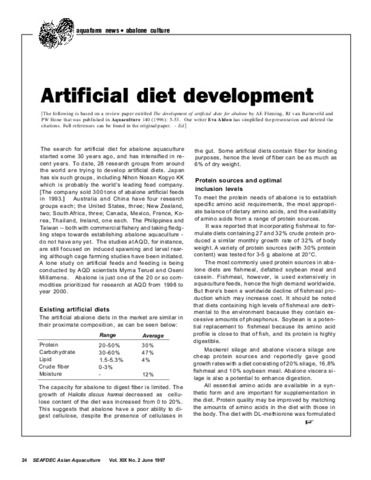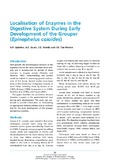Apparent digestibility coefficient of nutrients from shrimp, mussel, diatom and seaweed by juvenile Holothuria scabra Jaeger
| dc.contributor.author | Orozco, Zenith Gaye Almeda | |
| dc.contributor.author | Sumbing, Joemel Gentelizo | |
| dc.contributor.author | Lebata-Ramos, Ma. Junemie Hazel | |
| dc.contributor.author | Watanabe, Satoshi | |
| dc.date.accessioned | 2015-05-25T06:14:23Z | |
| dc.date.available | 2015-05-25T06:14:23Z | |
| dc.date.issued | 2014 | |
| dc.identifier.citation | Orozco, Z. G. A., Sumbing, J. G., Lebata-Ramos, M. J. H., & Watanabe, S. (2014). Apparent digestibility coefficient of nutrients from shrimp, mussel, diatom and seaweed by juvenile Holothuria scabra Jaeger. Aquaculture Research, 45(7), 1153-1163. | en |
| dc.identifier.issn | 1355-557X | |
| dc.identifier.uri | http://hdl.handle.net/10862/2252 | |
| dc.description.abstract | The ability of Holothuria scabra to digest nutrients, such as organic matter (OM), protein and carbohydrate from animal and plant feed ingredients was investigated. Four test feeds prepared by mixing sand with single ingredients from animal sources (shrimp and mussel) and plant sources (diatom and seaweed) were fed to H. scabra to estimate apparent digestibility coefficient (ADC). The total assimilated nutrient (TAN) increased with ADC, whereas ingestion rate (IR) varied slightly among the feeds suggesting that ADC might be a good indicator of nutrient availability to H. scabra. The ADCOM of shrimp and mussel was significantly higher than that diatom and seaweed: 86.2%, 77.1%, 55.1% and 32.3% respectively. ADCprotein was similar for shrimp (88.7%), mussel (84.8%) and diatom (75.2%), but significantly lower in seaweed (34.4%). ADCcarbohydrate was similar in mussel (58.5%) and diatom (58.3%) as well as in seaweed (31.6) and shrimp (28.0%). ADCprotein was relatively higher than ADCcarbohydrate suggesting that H. scabra generally digests more protein than carbohydrate. Furthermore, results indicated that nutrients from animal-based feeds are more efficiently digested by H. scabra; thus, animal ingredients rich in easily digestible protein could potentially provide an efficiently balanced diet for H. scabra fed with diatom containing high easily digestible carbohydrate. | en |
| dc.description.sponsorship | This study was funded by the Japan International Research Center for Agricultural Sciences (JIRCAS). | en |
| dc.language.iso | en | en |
| dc.publisher | Wiley | en |
| dc.subject | Holothuria scabra | en |
| dc.subject | Decapoda | en |
| dc.subject | protein content | en |
| dc.title | Apparent digestibility coefficient of nutrients from shrimp, mussel, diatom and seaweed by juvenile Holothuria scabra Jaeger | en |
| dc.type | Article | en |
| dc.identifier.doi | 10.1111/are.12058 | |
| dc.citation.volume | 45 | |
| dc.citation.issue | 7 | |
| dc.citation.spage | 1153 | |
| dc.citation.epage | 1163 | |
| dc.citation.journalTitle | Aquaculture Research | en |
| dc.subject.asfa | Bacillariophyceae | en |
| dc.subject.asfa | digestion | en |
| dc.subject.asfa | plant physiology | en |
| dc.subject.asfa | digestibility | en |
| dc.subject.asfa | feeding experiments | en |
| dc.subject.asfa | marine molluscs | en |
| dc.subject.asfa | phytoplankton | en |
| dc.subject.asfa | carbohydrates | en |
| dc.subject.asfa | seaweeds | en |
| dc.subject.asfa | feed composition | en |
| dc.subject.asfa | sand | en |
| dc.subject.asfa | organic matter | en |
| dc.subject.asfa | nutrient availability | en |
| dc.subject.asfa | nutrients | en |
| dc.subject.asfa | acids | en |
| dc.identifier.essn | 1365-2109 |
このアイテムのファイル
| ファイル | サイズ | フォーマット | 閲覧 |
|---|---|---|---|
|
このアイテムに関連するファイルは存在しません。 |
|||
このアイテムは次のコレクションに所属しています
-
Journal Articles [1258]
These papers were contributed by Department staff to various national and international journals.



